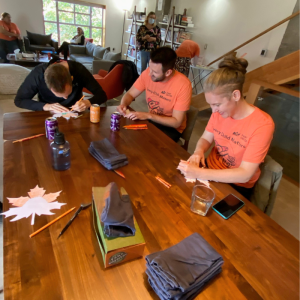Rev. Lauren Sanders, Indigenous Spiritual Care Chaplain, has written a blog in honour of National Day for Truth and Reconciliation. Rev. Sanders shares about the truth-telling and truth-listening aspects of truth and reconciliation, and how art—one of the key forms of communication—requires everyone to be a truth-listener.
Art is storytelling, and art is one of the oldest forms of truth that there is. We see art everywhere. When there are archeological digs or when you’re in Indigenous sacred spaces, there’s art. That art is telling a story, and that story tells the truth.
When we are journeying on this truth and reconciliation journey, it is vital that we look at songs, dances, and all art forms as part of ways to speak truth, hear truth, learn truth, unlearn truths that we don’t need anymore, unlearn lies, and relearn truths that we’ve forgotten about.
Truth-telling and truth-listening happen together in an open dialog. The truth hits hard, shining light on places within us and around us that we would rather not see or be seen. Allowing those hard truths to confront the lies we have believed takes humility, self-awareness, and courage. As we work to fully accept those hard truths, we realize that telling the truth is also very difficult. Telling hard truths also requires humility, self-awareness, and courage. The vulnerability of both the truth-teller and the truth-accepter is the beginning of trust. Only from that trust can reconciliation be built.
When we experience art, we have feelings about it. Feelings are the deepest and first way we encounter what we think of as spirit. Our body reacts, our mind reacts, and everything within us reacts when we feel feeling. With art, you’re supposed to feel feeling. That art tells us: this is the artist’s truth. You can like it; you can not like it. You can feel some way about it. But that was the point of the artwork. To feel some way about it.
When we encounter the hard truths from artwork, particularly Indigenous artwork, we all need to give ourselves space to internalize it and have it become a vital part of us in a way that allows the truth to become ours. The story isn’t to be usurped or subsumed. The truth in the story becomes our common humanity, our connection that breathes solidarity into being… again. In some creation stories, we were all one. We became fractured into “I only” through colonization, systemic oppression, and genocide. Listening to hard truths, whether through art or other means, moves us toward each other.
This National Truth and Reconciliation Day, I invite you to join us in reflection with the following questions:
When you’re looking at public art, what do you feel? What are some hard truths? What are the lies you believed?




Casey Stainsby, Student Pastor, and Rev. Lauren Sanders, Indigenous Spiritual Care Chaplain, hand-painted a maple tree at the FIRST UNITED Spiritual Care office. The tree will be adorned with paper maple leaves designed by FIRST UNITED staff. On each maple leaf, staff wrote a commitment to dignity, belonging, and justice for truth and reconciliation.